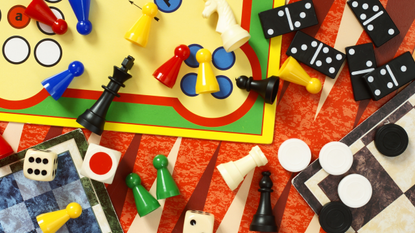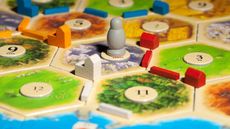The best cheap board games are ideal for entertainment anywhere, anytime. Whether you’re on your travels or stuck at home on a rainy day, this list of cheap board games are an affordable way to get family or friends together for a laugh. Most are quick and easy to learn for all ages, and are just as fun and engaging for all. So whether you need a new addition for your games night or you simply want a new way to engage the kids, these board games are the perfect thing for you.
Many of these games are also quick to play, meaning the kids won’t get board easily and they keep the energy flowing. However, if you’re into longer narrative-style games, we recommend checking out our guide to the best board games overall, as this includes a number of different types of game to suit your preference.
As we’ve said, most of these games are suitable for all ages, however any that are a little more difficult, we’ve flagged as not children-friendly. If you are specifically looking for family friendly games, check out our guide to the best board games for kids.
Not looking for big family games, but rather play head-to-head? We’ve got you covered with our round up of the best board games for two players.
What are the best cheap board games?
Why you can trust T3
Here's a quick run-down of the games under £20 that we love most. Read on for all the details, including pros and cons, ease of play and timings.
- The best cheap family board game: Ticket to Ride: New York – it feels like a bigger game than it is, but plays in under half an hour
- The best cheap board game for two players: Jaipur – a perfectly honed puzzle for two players to battle against each other
- The best cheap cooperative board game: Letter Jam – a clever game of making words and deduction
- The best super-small cheap game: Love Letter – at just 16 cards, this fits in anyone's pocket and is a full, rich game
- The best cheap board game for up to six players: Celestia – a beautifully-designed game of trying to fly an airship co-operatively (but not too co-operatively)
The best cheap board games 2023: the list
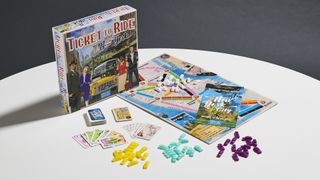

What a brilliantly realised, compact gaming package. This is a mini version of Ticket To Ride, one of the most popular board games of all time, but it doesn't feel cut back when you play. Instead, it feels more concise and actually more competitive in many ways due to the smaller size.
The game is easy to learn and play: you get points by claiming routes through New York with your colour of taxi. You'll draw cards that show you two destinations, and if you can connect them, you'll get big points. If you can't, you'll lose big points. The problem is that other people are also trying to make connections all over the board at the same time, and if they claim a route you need before you snap it up, you'll have to go the long way around.
You claim routes by collecting cards, for example, you'll need a set of all pink cards if you're planning to claim a route that's pink. You can only take two cards on a turn, though, and everyone can see what cards are available, so you can try to predict what other people up to (so you'll have to pay more attention than you might have initially expected).
The crucial part is how tight the board feels – there's nowhere near enough space, so it feels like a slow build up as people collect cards, until suddenly it's a mad rush to claim the routes you need before they're gone. Overall, it's a concise, fun game that plays in about 20 mins with satisfying conclusions! You'll want to clean down the board and go again – it's such a fun sprint, as our full Ticket to Ride New York review explains.

This is a cooperative game of deduction and word-making. Because it's cooperative, it largely avoids one of the major pitfalls of word/spelling games, which is that some people just tend to find it easier to pick a complex word from a jumble of letters than others. In Letter Jam, you still have a jumble of letters to make a word from, but because you're trying to come up with words that other people have to guess, there's no inherent value in longer or more obscure words.
The setup is a bit fiddly to explain (this is true while you're teaching it to others – although it's extremely easy to play, there'll need to be some patience in the explanation), but the gist is: each player has five cards face down in front of them, which spell out a word. The ultimate aim of the game is for every player to be able to say what their word is, without ever having looked at the cards.
The way to achieve this is with each round, all players have one of their five cards upright and visible to the other players at the table. One player will use the letter cards they can see to spell out a word, placing down tokens that specify where in the word each letter comes (1st, 2nd, etc). This word becomes a clue to all the other players about what the letter in front of them might be – if you can see that I have spelled a word that starts 'CR' and then the third and final letter is the card in front of you that you can't see, you could safely assume that it's a 'Y'. However, a third player has the 'C' in front of them, so they're looking at a three-letter word that ends in 'RY', and will be wondering if the first letter is a 'C' or a 'T' or a 'D'. But that's okay – because next round, a new word will be made that might cement which of those options it is.
When you're certain you know what the letter that's currently in front of you is, you can place it face down again, and bring up your next letter, keeping a note of what you think they are as you go. The challenge in the game is that the group only has a limited number of guesses overall. When you run out, everyone needs to make a guess as to what word their cards spell – you don't necessarily need to have worked out every single letter for this, of course!
We love this game because it's truly cooperative – nobody has all the information needed at any time, and everyone is relying on others to help them out. Domineering personalities can't overshadow play the way they can in some other cooperative games. You can also make it harder or easier as needed, by changing the length of the face-down word in front of each player.


Love Letter's theme (of being suitors of a princess) is very thinly layered on, maybe because it wouldn't be as appealing to depict what this game really is: a brutal series of two-minute knife-fights.
There are only 16 cards to play with, and a random one is actually left out of each round. Every card depicts a figure from the court with a value attached to them, and they all have a special power of some kind, which tend to be geared around either knocking other people out of the game, or avoiding being knocked out yourself. Everyone starts with a single card, and on your turn you draw a new card from the deck, and decide which of the two to play now (using its power), and which to hold for next turn. The aim is to either be the last person left when all others have been eliminated, or if more than one person is still in when the deck runs out, to have the highest-value card in your hand.
The brilliance of the game is how all the powers on the cards interact with each other, and how terrifyingly easy it is to be knocked out. The most common card of all lets you guess which card you think someone else is holding, and if you're right, they're gone, just like that! Other cards do things like let you look at what card someone else had, or force someone else to discard their card and draw a new one: pretty innocuous, except that if you do that the someone holding the Princess card (which is the best to have at the end of the game) they're instantly knocked out.
You play several rounds to finish a game, each of which is really quick. It's short and sharp game of deduction, cunning and no small amount of luck, but one you can play over and over again and it always feel fresh. All in a teeny box.


For two players, this is a perfect little package. It's compact, tight, and the core puzzle at its heart never gets any easier to solve, so it's interesting every time you play. The idea is that you need to collect goods of the same type to sell, which gives you points. There's a market of cards in the middle that both players can see, and every time you take something, it's replaced with new cards, so even if your opponent grabs lots of cards, that means a fresh batch of goods for you to pick from.
The dilemma is how long you wait before turning your goods into points. If you're the first to trade in cards of a particular type, you get more points than someone who does it later. But if you trade in more cards at a single time, you get bonus points. So the game is always tempting you to wait another turn or two, because maybe – just maybe – you could get the higher first-mover points as well as a bonus for selling lots of cards. If it comes off, you'll be laughing. But maybe (probably) your opponent nips in with a small sale of that type of card first, nicks the biggest points, then moves on to something new.
It's great, fast-paced stuff, and we really like how flexible it is for letting you change tactics. For example, you can take every single card in the market at once if you want, but you have to replace them, so you can effectively ditch your entire hand and take juicy new ones from the middle if it feels like that'll be more successful. Read our full Jaipur review for more on why we're such fans of it.


Pandemic is a modern classic cooperative game, pitting your team of emergency specialists against the ever-expanding spread of four diseases across the world. Will you be able to research the cures before it's too late? The Hot Zone North America version is almost the exact same game, but it's focused on three diseases over North America and the game only lasts around 30 minutes. Otherwise, all the same strategy and tough decisions are here, which makes it an excellent, inexpensive, pint-sized package, ideal if you liked the original.
The trick to Pandemic's brilliance is that it never lets you rest comfortable. On your turn, you have four actions, which you can use to travel around using coloured City cards, remove disease from the board, or trade City cards with other players, because you'll need to collect matching sets in order to find the cures you need. Then you draw new City cards, giving you more options for you next turn. But after every player's turn, more disease cubes appear on the board, and it's usually in cities that have already been hit.
If too many disease cubes end up in one location, it outbreaks and spreads more cubes to neighbouring cities. This might cause one of those other cities to outbreak too, chaining disaster. Too many outbreaks and you lose the game, but running out of disease cubes also makes you lose the game. And if the deck of City cards runs out, you lose, so it's no good to just focus on clearing disease and not researching, because there's a time limit.
So you all club together, making decisions on what you can triage this turn to avoid disaster, but equally trying to work which cities you can risk leaving in a precarious state, because you're running out of time to trade cards and find the cures. It's a great collective experience, and one you can blast through to victory in half an hour.
It does lack a bit of variety compared to full-size Pandemic, and the optional Crisis cards (which are extra negative cards, supposed to add unpredictable wrinkles to your game) don't really address this, as our full Pandemic: Hot Zone – North America review explains. But you know what else it lacks compared to the full-size version? The higher price.


Trivia quiz games don’t have the best reputation, but as we demonstrate in T3's full Shoot for the Stars review, this game is gunning to take the genre to a higher level. While the questions are mostly typical trivia, the answers are all numeric. The game then plays out like an auction, with all the attendant uncertainty, excitement and awkward moments, with players trying to increase their guesses for the answer without going over the correct value. Fast playing, simple and with a cool cardboard spaceship, Shoot for the Stars is aiming to win new fans to a neglected style of game.


Sushi Go! is a game of building a delicious sushi meal out of adorable pieces of food with faces! It's extremely cute (if you don't think about it too hard) and super-simple. Everyone starts with a big hand of cards, from which you take one and pass the rest to the player next to you. Every player does the same, so you'll be given a new and slightly smaller hand that you'll again take one card from before passing it on – this continues until you've run out of cards, then you'll add up the points from the cards in front of you, and go for another round.
The tactics are in deciding what cards you're going to take. Some sushi types are worth good points on their own, some are worth little if you have one but lots of you have several the same, some only give you points if you have the most of that type out of everyone, some stick around over later rounds and give you points at the end of the game… the possibilities are endless! It leads to big triumphs, and some rounds where the person before you keeps taking what you wanted just before you can – you'll have to adjust your plan as you go.
There's a bigger version of this game called Sushi Go Party, which has lots of extra sushi types that you can rotate in and out of play every time you bust it out, keeping it fresh (…get it?). It also supports up to eight players! Sadly, it's just over our price limit here.
There's also a new dice-based version called Sushi Roll that we really like: instead of cards to pass around, you have dice that you roll each time. It's a bit more interactive between players, because you can swap your dice with other players' if you'd prefer what they have, but again is more expensive.
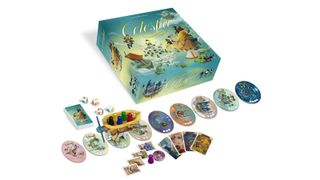

This is one of the biggest bargains in board-gaming – you get a beautiful 3D ship made of cardboard, a big pile of cards, and a really fun game, which is the important bit, really. It's usually available within our price range, though it's price fluctuates, and it's occasionally slightly over – forgive us, because it's so good.
You're all aboard a fantastical flying ship going from island to island, and each turn one player is the captain, who rolls some dice to see what the obstacles you'll encounter on the journey. To make it to the next island, the captain needs to have cards in their hand matching the symbols on the dice – they'll discard them to move on if they can, otherwise the ship crashes.
After the dice are rolled, but before cards are played, everyone else on the ship gets to decide whether to get off the ship and pick a treasure from the island; or whether to stay on and risk whether the captain will be able to beat the dice or not. The further the ship travels, the more each island's treasure will be worth.
Here's the kicker: the captaincy rotates after every single turn, in flagrant disregard for the need for qualifications. The captain isn't allowed to get off and there are also power-up cards people can play, which can both help and hinder the current captain or save you (and only you) from a crash.
After every crash, you go back to the start of the islands, and keep going until someone gets enough points to win. It's so easy to play, it's a ridiculous amount of fun, and it has the thrill of gambling without anything untoward.
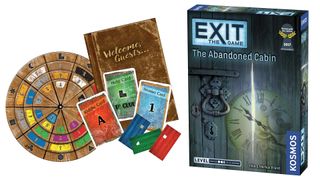

Exit: The Room is a whole range of games (there are 13 in total) that are designed to give you the escape room experience at home – each is based on a different theme, including 'The Abandoned Cabin', 'The Polar Station' and 'The Sunken Treasure'. Inside, you'll find components such as code wheels, cards, clues and all kinds of puzzles, which you'll have to work your way through.
We're not going to go into as much detail about these as we would for other games, because you obviously need to explore them yourself to get the real experience. Instead, we'll say that the puzzle levels feel perfectly pitched, they're really satisfying to crack and move onto the next stage, and the whole thing is ideal to bring together friends or family for a few hours. There's no worries about time or anything, making it less stressful than a real escape room.
Each box can only be played once, because you'll need to actually alter parts of the game at times. That might make them seem like less good value than the many replayable games here, but then this should keep up to six people entertained for a couple of hours, for just £13 or so. View the whole range of Exit: The Room games here.
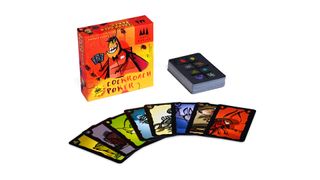

So cheap, so simple, so good. All you do in this game is trick your friends, either by lying or telling the truth, depending on which you think will bamboozle them most!
The 64 cards are divided equally among everyone, and divided evenly into eight different types of pest (rats, flies, cockroaches, etc). The illustrations of the pests are brilliant – there's a kind of rough, frantic, ’90s-Nickelodeon-show look to them.
If it's your turn, take a card from your hand, place it face down in front of someone else, and tell them 'This is a [pest name]'. You can choose which pest type to say – lie, or be honest. That person now has three options: they can say they think you're telling the truth; they can say they think you're lying; or they can pick up the card, look at it, and do the exact same thing to someone else at the table, with the option to change what they claim it is, branding you a liar (or not) in the process.
If they answer whether they believe you or not, and they're wrong, then the card goes face up in front of them permanently. If they answer and get it right, then it goes face up in front of you. The aim of the game is avoid having four of the same kind of pest in front of you, because that's an instant loss, and the game is over – there's no winner here, only a loser.
Within that simple frame work, there's so much scope for crafty thinking – when you pass someone a card that you claim is a rat when they've already got three rats face up in front of them, you put their mind in overdrive. Should they just say it's true, because then even if they're wrong, they still won't get a rat this turn? Should they just pass it on, because maybe that's slightly safer? Of course, it being such a fast and silly game, you don't have to think about it at all… it still works great.
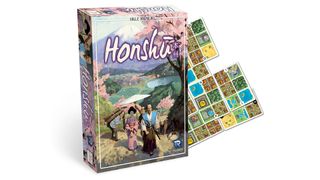

There's so much game in this box! Honshu is a pretty little game of building a pretty little Japanese town. Each turn takes place in two phases: first, you'll choose a card from your hand, which has six squares on that represent different zones: housing, resources, factories, parks, lakes, and empty brown land. Everyone puts their cards in the middle, and whoever's card has the highest value written at the top gets to choose which cards they want from everyone's options – then the second highest, and so on.
Once everyone's got a card, you'll build up your town by placing that card next to a tableau of cards you've already placed, trying to maximise how many points it gives you. Houses get you small amounts of points each, but if you form them into a big cluster, it really adds up. Lakes are worth tons of points if you chain several of them to touch each other, but are barely worth anything on their own. Factories give you points at the end provided you have a matching resources square… everything has a use.
After twelve rounds, you've built up a sprawling town, maybe using the cards you wanted, or maybe using whatever you were able to pick up. Even if you lose ultimately, there's a deep satisfaction to looking over what you've built.
This all already makes it highly repayable – you'll have to change your tactics every time depending on what cards you get – but it also comes with a couple of ways to change the game in the box. One gives every town a totally different starting card (they're all essentially identical normally), changing your tactics further; another adds bonus ways to score on top of the usual ones, giving you even more ways to build.


You are ocean-floor treasure hunters, diving down from your submarine to grab swag. The problem is that you're cheapskates, so everyone (up to six players) is sharing the same oxygen supply. And it runs out much quicker than you think.
You lay out a path of face-down tiles from the submarine, and then roll dice to see how far along the tiles you'll move. After you move, you have the option of picking up whichever tile you're on, and having it as treasure – it has a points value printed on the underside. You can then keep moving down the track if you like (later tiles are worth more), or at some point you announce that you're turning back, and then move up towards the submarine. If you make it to the submarine, you get to keep your treasure.
The problem is that every treasure you pick up makes the oxygen counter move down by an extra notch on your turn – and also takes one point of movement off whatever you roll. And remember, there's one oxygen counter for everyone, so the greedier people are cutting down how much time you have left as much as themselves. It's common to end up just one space outside the submarine, with enough oxygen for one more turn, banging on the outside desperately hoping to be let in… and rolling too low to move.
After each round, the gaps in the path left from treasure taken so far are squeezed up, bringing the higher-value tiles within reach, making dangerously deep dives even more tempting.
This comes in a teeny tiny box, and is one of the most beautiful games ever made – the design is just gorgeous, from the box art to the submarine design to the little wooden diver figures to the tokens of different shapes for different quality of treasure.
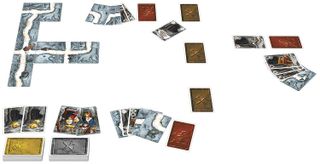

Another small game that casts you all as dwarves digging a mine to find gold nuggets. You all have hands of cards with paths drawn on them, and on your turn you can lay next to existing path cards to make a route from the entrance to the three end cards – one of them has the all-important gold, but you won't know which at first. However, one of you might be a saboteur, who only wins if everyone else loses, and who'll try to block you off with dead ends, and rock falls, and by breaking your tools so you can't lay cards.
If you work out who the saboteur is, you can try to neutralise them… but some people will end up acting suspiciously even if they're not the saboteur, because whoever gets to the gold first will get more of it than anyone else – maybe you end up breaking people's tools just to slow them down, so you get to lay the final card.
It plays up to 10 players from one little box, and the amount of saboteurs scales up too, so it's actually most interesting at higher player counts, where some some saboteurs might be openly ruining everyone's day, while others are still pretending to be friends, biding time to turn on the legit players.
It plays quickly, there's a great level of intrigue, and takes about two minutes to learn. It's a worthy addition to any board game collection.
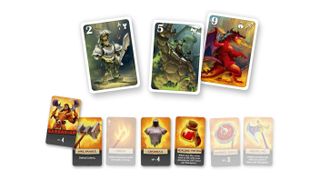

Oh, you're the toughest adventurer, we all know that. You can definitely defeat a dungeon full of monsters, no worries. But can you do it without your shield? Yes? Okay, without your sword? Well, maaaaybe?
This game is a bravado balancing act. Each round, one of the players will have to take an adventurer on a run through a deck of cards filled with monsters, seeing if they can get all the way through without losing their health. Succeed, and you get a point – just two points to win! Fail and you lose a life – just two losses and you're out! But all this occurs at the end of a round, and what happened before determines whether it will work out or not.
The first part of the round is players taking turns to pick up a monster from a deck of them, looking at it secretly, then deciding whether to put that monster into the dungeon, or keep it out of the dungeon – but if you do the latter, you also have to remove one piece of equipment from the adventurer. Some gear gives them more life, some kills certain monsters with no damage taken, some has other powers. If you think things are looking too hairy, you can pass at any time, removing yourself from the round – you won't gain anything this round, but you won't lose anything either. The last person who hasn't passed will be the one taking the adventurer through the dungeon, flipping over monster cards, with each one either damaging the adventurer or being killed.
It's surprisingly tactical and thrilling, which isn't an easy combination. You can bluff, sort of, by keeping a very high-damage monster out of the dungeon, and removing the one piece of equipment that could kill that monster – to everyone else, it will look like you're making the adventurer very vulnerable, but you know that actually it balances out.
And then you all get to watch someone make the run, yelling when a really weak hero somehow makes it through with one point of health left, or cheering when a tricked-out hero is laid low by a dragon, and feeling smug that you withdrew from the round at just the right moment.
